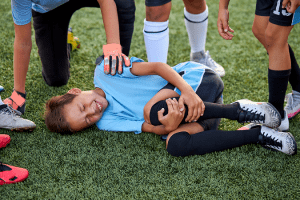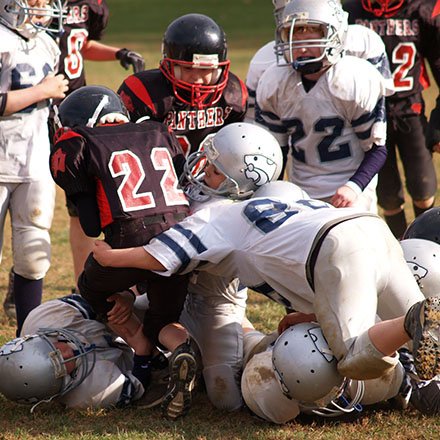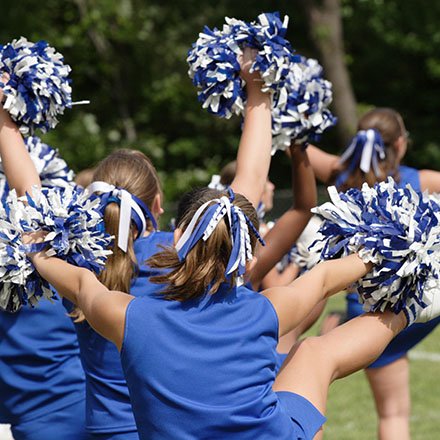Avoiding Opioid Exposure in Youth Athletes – A Playbook for Coaches and Parents
As part of our educational partnership with Pacira BioSciences, Inc. – a company leading the charge in driving awareness for non-opioid pain management options – this post aims to provide coaches and parents with information to help youth athletes avoid the risks of opioid exposure that can stem from sports-related injuries and surgeries.
Being the parent, guardian, or coach of a youth athlete can be highly rewarding. Aside from watching a child’s hard work pay off on the field or court, organized youth sports foster important life skills like teamwork, resourcefulness, compassion, and self-discipline, along with increased emotional well-being and cognitive improvement. Contributing to this type of growth can feel like you’ve just won the championship game!
 But playing sports also comes with an increased risk of injury. Especially as the attention and publicity associated with promising young athletes grows, so does the pressure to perform, leading to potential overexertion and overuse injuries. This concern is heightened even further if young athletes begin to rely on pain medication to try and play through the pain or end up needing surgery. As we see in headlines on a daily basis, opioids can have significant dangers, such as downstream illicit use or addiction. Yet, they are often prescribed to treat pain from a sports injury and/or surgery.
But playing sports also comes with an increased risk of injury. Especially as the attention and publicity associated with promising young athletes grows, so does the pressure to perform, leading to potential overexertion and overuse injuries. This concern is heightened even further if young athletes begin to rely on pain medication to try and play through the pain or end up needing surgery. As we see in headlines on a daily basis, opioids can have significant dangers, such as downstream illicit use or addiction. Yet, they are often prescribed to treat pain from a sports injury and/or surgery.
Luckily, innovations in modern healthcare give you the opportunity to advocate for your athletes. There are non-opioid options that can help minimize, or even eliminate, the need for opioids.
Know the Numbers
Almost a third of teens who receive an opioid prescription before high school graduation will go on to misuse opioids in the future. Because of an increased likelihood of being exposed to opioids due to injury, young athletes may be at an even greater risk for opioid misuse or addiction. In fact, high school athletes had a lifetime opioid use rate between 28% and 46% — rates that approach those of NFL athletes!
With this cause for concern, how can coaches and parents work to keep young people safe? As a parent, guardian, or coach, you’re uniquely positioned to protect youth athletes. In partnership with Pacira BioSciences, Inc., we’ve created a playbook of ways to prevent injuries from happening in the first place and how to navigate the opioid conversation with a doctor if an injury leads to surgery.
Coaches Playbook: Injuries
Coaches play a crucial role in preventing injuries, as they set the tone for the relationship children and teens have with sports. Pushing our kids to do their best and pushing them too far can become a fine line, but there are various ways to ensure that your team is practicing and playing safely.
Start by simply talking to the group about the importance of warming up and stretching. Reassure them that if they do not feel well or have even a minor injury, they should rest and fully recover prior to jumping back into any activity. Try to include parents in these conversations as well, so that they understand your expectations, and can ask questions or help continue the discussion at home.
Once you’ve covered your bases, put these thoughts into practice – literally! Start each practice or game day with an extensive stretch session and active warm-up to help loosen up your players’ muscles and increase their range of motion. Encourage frequent water breaks and a nutritious diet, as dehydration, especially in the summer, can lead to over-exhaustion and heat-related issues.
Overuse or playing through an injury can often lead to something more serious, so be sure to educate yourself and recognize the signs of injury early, and have open conversations with your athletes about how they’re feeling. Some may try to play through the pain but trust your instincts when you feel it’s time for them to rest.
Coaches Playbook: Surgery
If a child you coach ends up needing surgery, you can help reassure parents that their child will be taken care of and looked after, especially during their recovery. Let parents know that there are non-opioid options available that may be able to help their child recover quicker after surgery and avoid unnecessary exposure to opioids. Fortunately, these options can also enhance a child’s overall recovery and get them back to the sport(s) they love. As a coach, it’s also important to be aware of any surgeries your players may be undergoing, especially as they come back to the field. When possible, work as a team with the child’s parents or guardians to get a better sense of how they’re recovering and if they’re ready to ease back into the game.
Parents and Guardians Playbook: Injuries
It’s equally important for parents/guardians to be able to recognize an injury, especially if their child needs to see a doctor. Some signs that a sports-related injury could be more serious and may need medical attention include consistent pain during and after sports, swelling around a joint, instability in the joint, painful pops, or pain that persists even after a rest period. If your child is experiencing these symptoms, schedule a visit with their physician to discuss next steps.
Parents and Guardians Playbook: Surgery
If an injury is serious and surgery is required, it’s natural to have concerns about the amount of pain involved and what to expect when your child is recovering. How your child experiences pain often depends on the type of surgery they are looking at and their own individual tolerance level. How your child recovers is also dependent on how their pain is managed.
In any case, your child’s doctor will create a pain management plan. Oftentimes, this will include a combination of medications – called a multimodal approach – which is the best way to reduce opioid exposure. Non-opioid options can include medications like intravenous (IV) acetaminophen, non-steroidal anti-inflammatories (NSAIDs), long-acting numbing medications, and others. You can do your own research into some of the non-opioid options available for use in pediatric surgeries. For instance, local anesthetics are injected during a procedure and release numbing medication over an extended period of time to help relieve pain.
In addition to managing pain after surgery with minimal use of opioids, non-opioid approaches are also aimed at helping patients reach important recovery goals, such as moving, walking, eating, and getting back to normal daily activities. In fact, many side effects of opioids – such as nausea and drowsiness – can hinder these aspects of recovery.
Many parents don’t realize they can be involved in these pain management discussions and decisions in collaboration with their child’s physician, but pain management plans should always be tailored to the patient. As a parent, you should feel empowered to have a conversation with the doctor about what their planned pain management approach entails. Ask about ways to reduce your child’s exposure to opioids. Many physicians may already include non-opioid options as part of their protocol, but it’s important to confirm their approach prior to surgery. You can also ask questions such as how to wean your child off of opioids if they are prescribed, and when certain non-opioid options may begin to wear off. This can also help you manage expectations for your child’s recovery.
Stay Educated
Injuries and surgery can be tough. If and when they happen, parents and guardians should feel empowered to have an active voice in the conversations surrounding their child’s pain management plan, especially regarding opioid prescriptions. Coaches can help kickstart these conversations when surgery comes into play by reminding parents of these options and their ability to request non-opioids. Begin to talk about these options early so you can evaluate what the best plan is for your child ahead of surgery. To ensure you’re prepared with questions, download a discussion guide that you can use at the appointment.
To learn more about pain management, injury prevention, and what to do if your child needs surgery, visit ncys.org/safety/pacira/.




